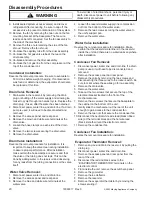
Component Testing
To avoid risk electrical shock, personal injury, or death,
always disconnect electrical power source to the freezer
before attempting to service, unless test procedures require
power to be connected. When removing any wiring from terminals they must be replaced on the same terminals.
Ensure all ground wires are connected before certifying unit as repaired and/or operational.
WARNING
!
©2003 Maytag Appliances Company
16022217 Rev. 0
9
Refrigeration System Test Procedures
The following should always be practiced with any sealed
system that is opened. Only open the sealed system as
the final diagnosis. Check all basic areas such as wiring,
water supply, drain setup, proper airflow first. Many times
these areas can resemble sealed system problems. The
diagnosis of a sealed system problem can be determined
by accurate pressure and temperature measurements.
1. Use a leak detection system that will detect R-134A
refrigerant. Leaks need to be found on any leaking
system
before
repair takes place.
2. The drier must be replaced anytime the sealed
system is opened. Failure to use correct part will
result in repeated sealed system failure in the near
future.
3. Limit time the system is opened.
DO NOT EXPOSE
OPEN SYSTEM FOR MORE THAN 15 MINUTES.
This will result in sealed system failure. Leave
replacement parts sealed and/or pressurized until
ready to install.
4. The compressor must be replaced if there is a low
side leak. Moisture has been drawn into the system if
the unit has been running for extended period of time.
Be sure to flush the system with dry nitrogen gas and
evacuate to 50 microns before re-charging.
5. A new evaporator assembly must be ordered if the
capillary tube is found to be plugged or severely
restricted. Restrictions cannot be flushed out.
6. Be sure to purge the system after final brazing. This
will flush out any air or moisture that may have
entered the system before being absorbed into the
ester oil.
Low Side Leaks
Low side leaks consist of a break in the system at the
evaporator, low side (suction) return line, or accumulator.
If a leak is found in any of these areas, moisture has
probably entered the system. The compressor, drier, and
hot gas valve will have to be replaced and the system will
need to be flushed thoroughly with nitrogen gas and
evacuated to 50 microns before recharging.
High Side Leaks
High side leaks consist of a break in the system at the
condenser, high side tubing, drier, or capillary tube. If a
leak is found in any of these areas, the system can be
flushed with nitrogen gas, evacuated to 50 microns, and
recharged.
Restricted Capillary Tube
Moisture or other contaminants that enter the system can
cause deposits in the system. These deposits will usually
collect in the capillary tube and form a restriction that
cannot be completely removed by flushing. If the
capillary tube is found to be restricted, the evaporator,
compressor, condenser and drier should all be replaced.
Access Valves
A temporary access valve can be used to service or
evaluate the system. The access valve can be installed
on the compressors process tube (this will also be a low-
pressure side). Be sure to cap off access valve while
servicing. This will prevent contamination of the system
and/or refrigerant from leaking.
After servicing, the
access valve should be removed
. A pinch-off tool can
be used to close the system to remove the access valve
and then braze the hole for the access valve to seal the
system. Be sure to leak check after brazing.
Pressures and Temperatures
There are three ways to measure the temperature of the
evaporator plate.
1. Use a thermocouple to measure the temperature of
the evaporator. The thermocouple must be secured
to the evaporator. The best and accurate location for
the thermocouple end is where the thermistor is
secured to the evaporator. Allow anywhere from 5°-
8°F of variation in measured temperatures if you
measure on the plate because of the thermal
conductivity of stainless steel thermistor in
comparison to the thermocouple.
2. If it has been determined that there is proper contact
between the thermistor and the evaporator plate, the
thermistor resistance value can be corresponded to
the temperature .










































